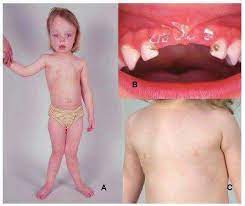Infantile Hypophosphatasia:

A family of children diagnosed with the rarest of diseases — Infantile Hypophosphatasia struggling to get these genetic disorders included under the Centre’s National Policy for Rare Diseases (NPRD).
- Infantile Hypophosphatasia is a rare genetic disease in which the patient’s bones and teeth demineralise, making her fragile and prone to fractures.
- It may have no noticeable abnormalities at birth, but complications become apparent within the first six months of life.
- The initial problem may be the baby’s failure to gain weight and grow as expected, referred to as “failure to thrive.”
- Sometimes the skull bones fuse, called craniosynostosis, which can lead to a deformed head (brachycephaly).
- Affected infants have softened, weakened, and deformed bones consistent with rickets.
- Rickets is a general term for complications due to defective skeletal mineralization during growth with softening of bone and characteristic bowing deformities.
- It is caused by mutations in the ALPL gene.
- This is the only gene that causes HPP. Genes provide instructions for making proteins that have an important function in the body.
- When a mutation occurs, the protein may be faulty, inefficient, or absent, as in HPP.




